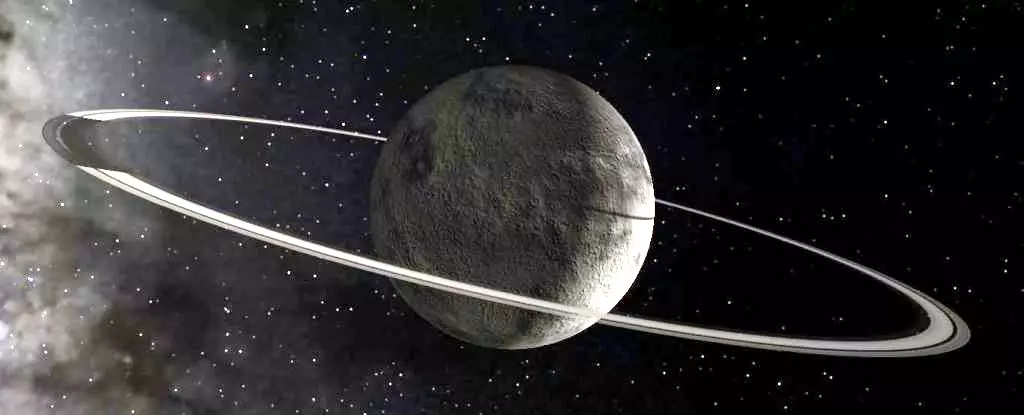In the far reaches of our Solar System, beyond the orbit of Jupiter, lies an intriguing celestial object named Chiron. Classified as a centaur, a category of hybrid objects that share characteristics of both asteroids and comets, Chiron stands out even among its peers. Recent insights from the James Webb Space Telescope (JWST) have unveiled fascinating details about this enigmatic body. As physicist Charles Schambeau from the University of Central Florida pointed out, Chiron exhibits a rare combination of comet-like and asteroidal traits that prompt deeper investigation into its unique behaviors and evolutionary history.
What distinguishes Chiron from other centaurs is its inclination to exhibit both cometary activity and a ring system—features typically associated with planets rather than small Solar System bodies. With its peculiar nature and the capability to generate small outbursts of gas and dust, Chiron raises profound questions regarding the dynamic processes shaping it and, by extension, offering a glimpse into the conditions of the early Solar System.
The Significance of Centaurs
Centaurs exist in a volatile zone between the gas giants Jupiter and Neptune. Their orbits often intersect those of these giant planets, placing them in a unique position to interact with gravitational influences that can modify their trajectories and physical characteristics. These celestial entities are thought to be remnants of the primordial material from which the Solar System formed approximately 4.5 billion years ago. While many of these objects have remained untouched by solar radiation due to their distance from the Sun, Chiron’s proximity allows us to study the processes that transform icy bodies into active celestial phenomena.
The implications of studying Chiron extend beyond curiosity; understanding the interactions its materials exhibit could provide critical insights into the formation and evolution of other planetary bodies. The changes occurring on Chiron offer a snapshot of a more ancient era—a time when the Solar System was still in its infancy.
JWST: A Window into Chiron’s Secrets
Recognizing the need for a closer examination of Chiron, a team of researchers led by Noemí Pinilla-Alonso from the University of Oviedo turned to the advanced capabilities of the JWST. This powerful telescope is designed to observe distant objects in the universe with unprecedented clarity. By focusing on Chiron, the team hoped to discern detailed information about its composition and the gases emitted by its surface during comet-like outbursts.
Currently, scientists are particularly interested in the nature of the substances within Chiron’s coma and how they correlate with the ices on its surface. Understanding the composition of both is crucial for constructing a comprehensive model of their interaction, which, in turn, can reveal significant aspects of Chiron’s evolution. The study of these relationships may indicate how the physical and chemical characteristics of Chiron’s ice have changed due to solar energy over time.
Employing JWST’s near-infrared capabilities, researchers aimed to decode the complex spectrum of light received from Chiron. This spectral analysis allows scientists to identify various molecular signatures present in the atmosphere surrounding Chiron. Prior studies have uncovered compounds such as carbon monoxide and cyanide, but the latest findings have added to this list a plethora of gases, including carbon dioxide, ethane, propane, acetylene, and water ice.
Among these discoveries, the detection of methane stands out, suggesting a rich and active chemical landscape governing Chiron’s coma. The implications of these findings are profound. They suggest that Chiron may harbor pristine materials dating back to the formation of the Solar System, while also potentially containing compounds created through surface reactions over billions of years—a fascinating duality that makes Chiron a compelling object of study.
The team’s observations are only the beginning. As they continue to monitor Chiron, researchers hope to observe how its behavior shifts in response to the Sun’s heat as it travels through its orbit. This will not only enhance our understanding of Chiron as an individual entity but also shed light on the broader dynamics of similar objects throughout the Solar System.
The journey of unraveling Chiron’s mysteries underscores the importance of observational astronomy in enhancing our knowledge of the cosmos. Through continued exploration, we stand to glean invaluable insights not only about Chiron but about the broader narrative of solar system formation and evolution. Each strange quirk of Chiron may unlock clues to the conditions present during the birth of our Solar System—giving us a glimpse into the distant past that has shaped our celestial neighborhood.


Leave a Reply